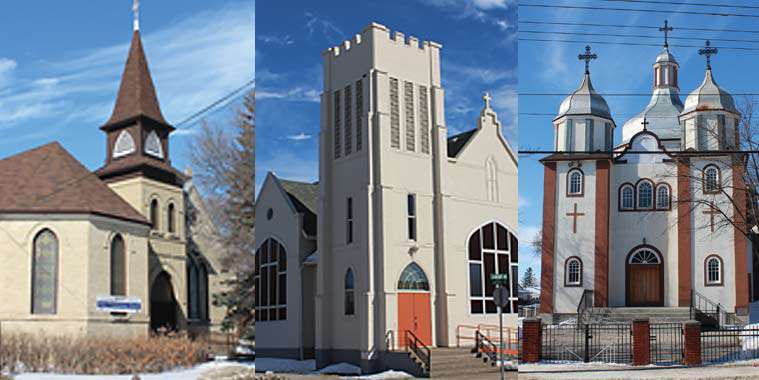Last week, a report by the National Trust for Canada warned that the country could lose more than 9,000 churches in the next decade due to closure and neglect. Three of Selkirk, Manitoba’s oldest churches, however, still serve their congregations with weekly services.
Knox Presbyterian Church
(1879, 1904, 1968)
341 Eveline Street
In autumn 1876, Rev. Alex Matheson travelled by horseback from Little Britain, Manitoba, to hold a church service for six Presbyterian settlers in a home on Eveline Street. That was the genesis of Knox Presbyterian Church.
The church was constructed in three phases, the first being a small chapel in 1879. Most of the present-day building, which absorbed the original chapel, was built in 1904 from a design by Winnipeg architect Samuel Hooper.
Hooper was working on the drawings into March 1904, just three months before he was appointed Manitoba’s first provincial architect. He would go on to design such landmark buildings as the Neepawa Land Titles Office, Brandon Court House and many of the original University of Manitoba Fort Garry Campus buildings.
The foundation stone for the new $8,000 Knox Presbyterian Church was laid on June 28, 1904 by Lieutenant Governor David McMillan and it was dedicated on December 18. The dedication service was led by Dr. Rev. Kirkpatrick of Manitoba College and Rev. R. M. “Klondike” Dickey, the congregation’s minister. For entertainment, there were musical numbers and Rev. Dr. Charles Gordon, a.k.a. Ralph Conner, did selected readings from his popular novels.
A newspaper report of the day described the interior this way, “Two beautifully coloured windows grace the east and west sides of the main auditorium... The whole of the interior is finished in natural colour fir. It is brilliantly lighted by electricity.”
In 1962, two new stained-glass windows created by Leo Mol were installed. A new wing, called Knox Centre, was added along McLean Avenue in 1968.
Selkirk Evangelical Lutheran Church (1924)
329 Clandeboye Avenue
Lutherans in Selkirk have worshipped at the corner of Clandeboye Avenue and Jemima Street for 120 years.
The Selkirk Lutheran Church was created when a group of Icelandic Lutheran settlers gathered for a service on June 19, 1889 under Rev. Magnus Skaptason and decided to organize as a congregation. A small chapel was then built on Rosser Avenue.
A decade later, the chapel was moved to this piece of land and work soon got underway on the construction of a larger church. Tragedy struck in the summer of 1919 when that new building was struck by lightning and burned to the ground. The congregation worshipped at the nearby Lutheran church hall until they could raise funds to rebuild.
The cornerstone was laid for the current 300-seat church on June 17, 1924. The $12,000 building is of timber construction atop a concrete foundation. Its 227 kg brass bell, purchased by the Ladies’ Aid Society, was hoisted into place as soon as enough of the bell tower’s superstructure was completed to hold the weight.
Selkirk Lutheran Church was dedicated on October 12, 1924 and the congregation was able to show off its new building to an international audience the following summer when it hosted the 41st annual meeting of the Icelandic Lutheran Synod of America.
The church’s longest serving minister appears to be Rev. Niels S. Thorlaksson who served from 1899 to 1927. Born and raised in Iceland, he came to the U. S. in his early 20s and settled in North Dakota. When hired by Selkirk Lutheran Church, he relocated to Manitoba with his wife and six children, one of whom would become esteemed Manitoba physician Dr. Paul Thorlakson.
Holy Eucharist Ukrainian Catholic Church (1957)
380 Sophia Street
The first Greek Ukrainian Catholic Church, as it was then known, was constructed in the City of Selkirk in 1917. By the 1950s, that building was too small for the congregation’s needs and they turned to architect and priest Fr. Phillip Ruh to design a new one.
Born in France in 1883, Ruh was ordained in Holland and came to Canada three years later. He had no formal degree in architecture, but it became his passion. He is credited with designing dozens of Ukrainian Catholic churches on the prairies and in Ontario. His best-known work is likely the Immaculate Conception Ukrainian Catholic Church and Grotto at Cooks Creek, now a national heritage site.
On October 2, 1955, the cornerstone for the new Holy Eucharist was brought by a procession of 300 people from the old church, which stood on the opposite corner of the intersection, to the new site where it was then blessed and laid. Both Ruh and parish priest Rev. Roman Dobrianksy presided over the ceremony.
The 350-seat church was built mostly from volunteer labour and was not officially opened until December 1, 1957.
Holy Eucharist’s floorplan is in the shape of a cross. Its most prominent external feature is its large central dome clad in silver sheet metal and topped with an iron cross. Two smaller domes adorn the towers near the main entrance.
In 1971, Ukrainian-born artist Theodore Baran of Saskatoon was hired to adorn the interior with murals. This includes one on the wall behind the altar depicting the holy eucharist and smaller images of Mary with Jesus and Jesus alone over the two side altars.
Christian writes about local history at his blogs, West End Dumplings and Winnipeg Places.



